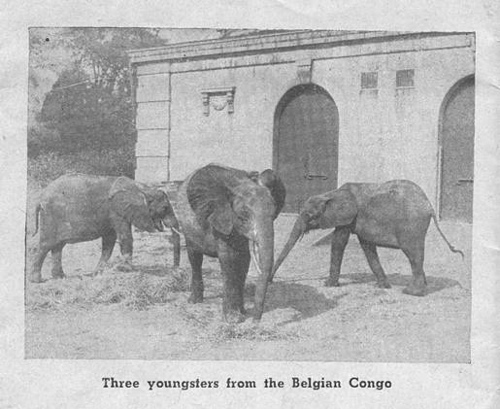This is the way the trio looked when I saw them at Bronx zoo in August 1947. The male cyclotis Zangelima (Barney) is facing the camera. On the right is female cyclotis Doruma (Pinky). On the left is the bush elephant Bamangua. Note that her ears are large and fan-like while the two cyclotis have the typical rounded ears. |
Monday, February 23, 2009
From Richard Reynolds #2
Posted by
Buckles
at
2/23/2009 05:26:00 PM
![]()
Subscribe to:
Post Comments (Atom)






8 comments:
Richard,
What the heck is a cyclotis? School's on, please elaborate.
Wade Burck
"Loxodonta Cyclotis" is the scientific name for the African forest elephant....formally Loxodonta africana cyclotis
The term cyclotis refers to the "rounded" ears of these elephants
Up until recently, it was considered a sub-species of the African elephant . Recent DNA testing was done with tail hairs from both African Savannah and forest elephants and scientist concluded that they were genetically very distinct. Almost as different as Asian vs. African.
This is a great blog...being interested in elephants, I come here often!
Does this mean that the Ringling "umbrella-eared" elephant Fannie was a bush elephant? Maybe you can identify some famous circus Africans [Jumbo, Mike, Topsy, Diamond, etc.] by their species?
There's an old [19th century] collection of circus elephant tail hairs in existence. It would be interesting to see some DNA testing done with them, if they were viable samples.
Forest elephants can be readily identified if you know what to look out for.
Firstly, they are psychically smaller than the Bush species..with females around 6.5-7ft and males around 8ft tall at the shoulder.
Their heads seem a little squashed but this may be due to a slightly longer lower jaw compared to the bush elephants....its not vertically long like in the Indian but horizontally lengthened.
The skin is much smoother and not as deeply wrinkled as the bush..this is most noticeable on the trunk. Forest elephants generally don't have the deep ringed wrinkles like the bush.
Their ears are much more rounded in shape, this includes the lower lobes. Also, their ears hardly fold backwards at the top...which is common with bush elephants as they age.
With females, the tusks are exceptionally thin in comparison with the bush species. With males they can grow to be quite thick. Also the ivory is very yellower in color and harder which makes it not as good for carving. Young bulls can grow quite long tusks in their teens and it is these individuals who have been labeled pygmies. In reality they are still sub-adults but with fast growing tusks.
Their tails are quite long and thin, though not as long as Indians but more than the average bush.
They normally have the same number of toenails as an Indian- 5 on front, 4 on back.
They have much more sensory hairs covering their trunks and mouth region compared to the bush.
Lastly, the forest and bush species do cross breed in certain areas so you will find populations with a "mix" of both. But with that being said, the points above should help identify a true forest elephant.
They're also really rare now in captivity out side of Africa. I believe there is one bull in France and a few cows in Japan.
Hope this helps.
Also, I looked up Fannie in Buckles archives and she appears to be a bush elephant, not forest. Jumbo was for sure a bush as well.
Richard: Thanks so much for sending the articles and photos. I am going to send printouts to Bill Conway who I'm sure will enjoy the trip down memory lane.
I can vividly remember feeding Sudana as a small child and the awe with which I viewed her. At my then very young age she seemed as thougn she was 20 feet tall.
Hoxie was a Forest Elephant ? !
Paul G.
http://www.arkive.org/forest-elephant/loxodonta-cyclotis/video-09.html
The above link will take you to a site called ARKive where they have 13 video's of the Loxodonta Cyclotis or forest elephant....
Does anyone know of any information about a young male Indian elephant named Runga. He came to the Bronx Zoo in 1930 and was shot in 1940. He was about 13 years old when they shot him. I have been trying, for years, to get a picture of him. There do not seem to be any. He is mentioned in one of Ditmar's books as small and bad tempered. I wanted to see what he looked like, if he was a tusker etc. I hope someone can help me.
Post a Comment